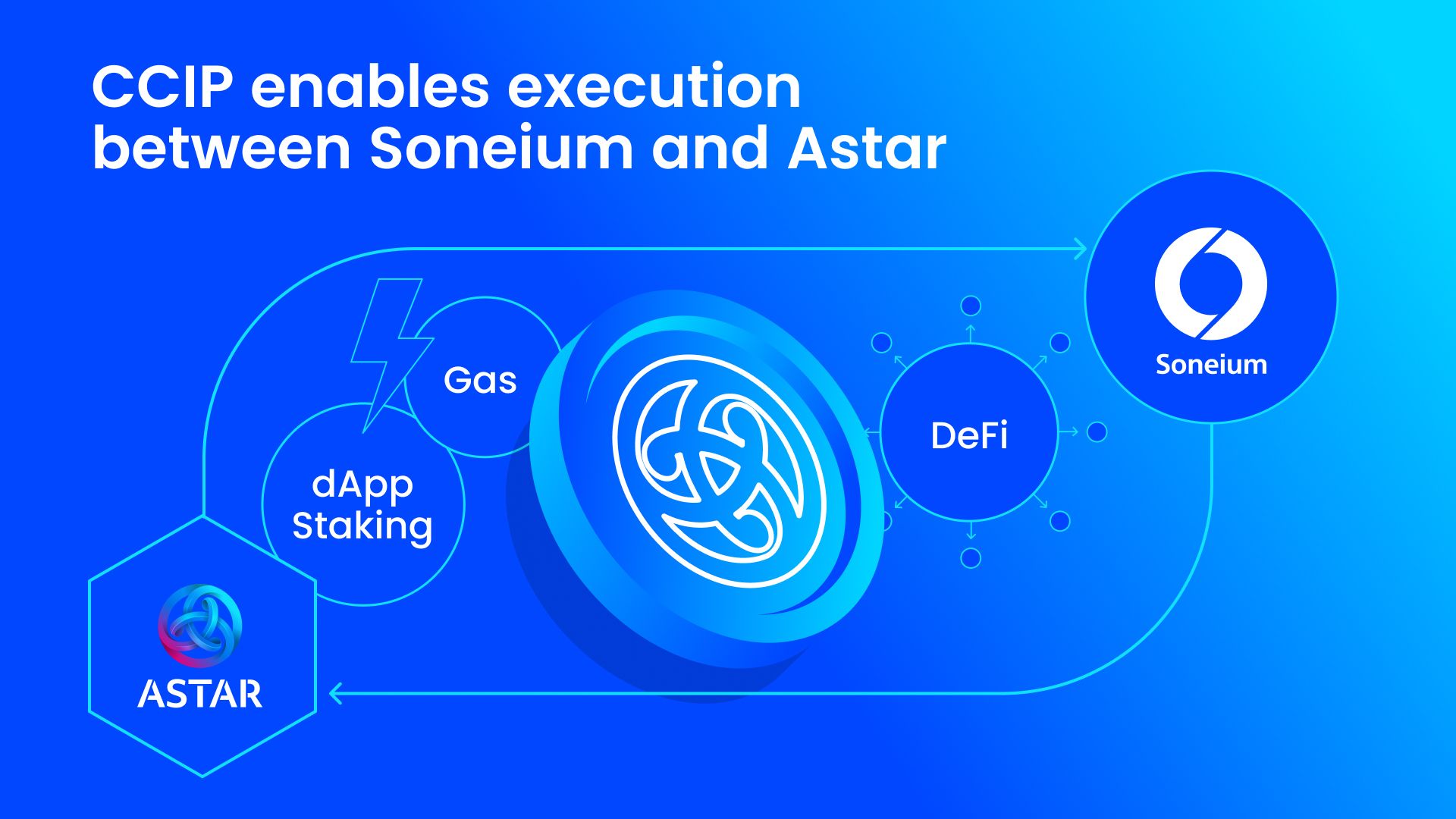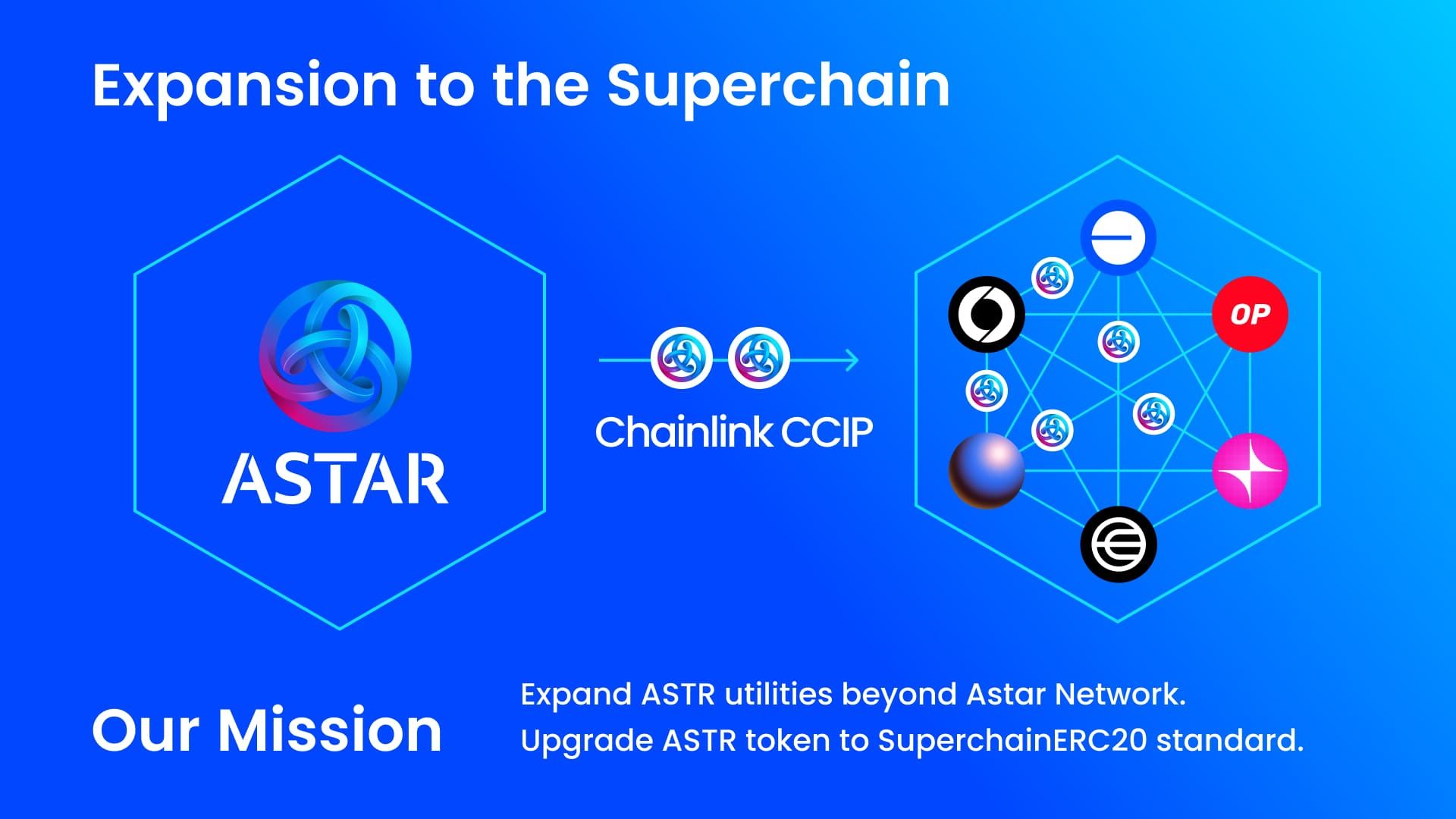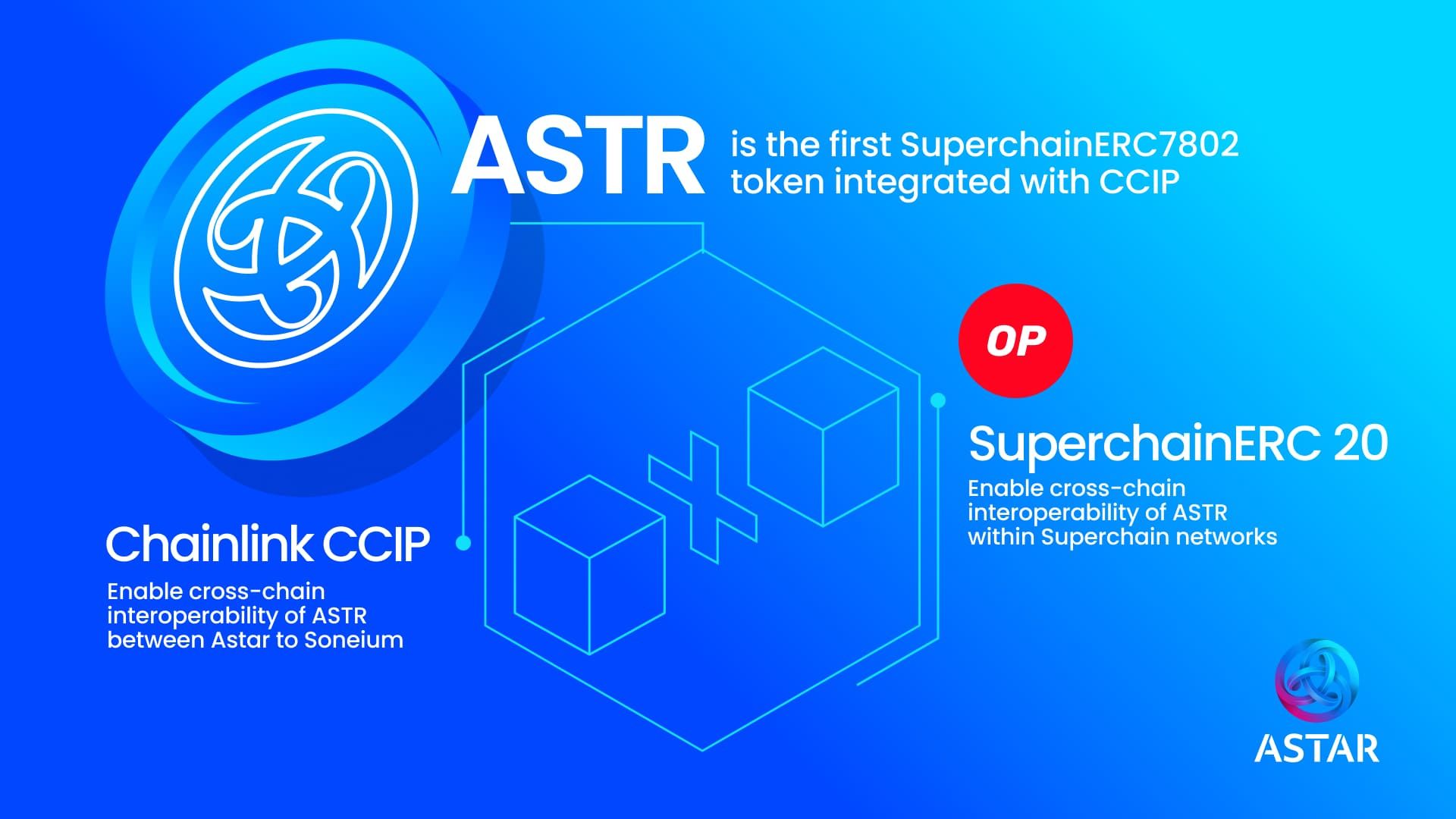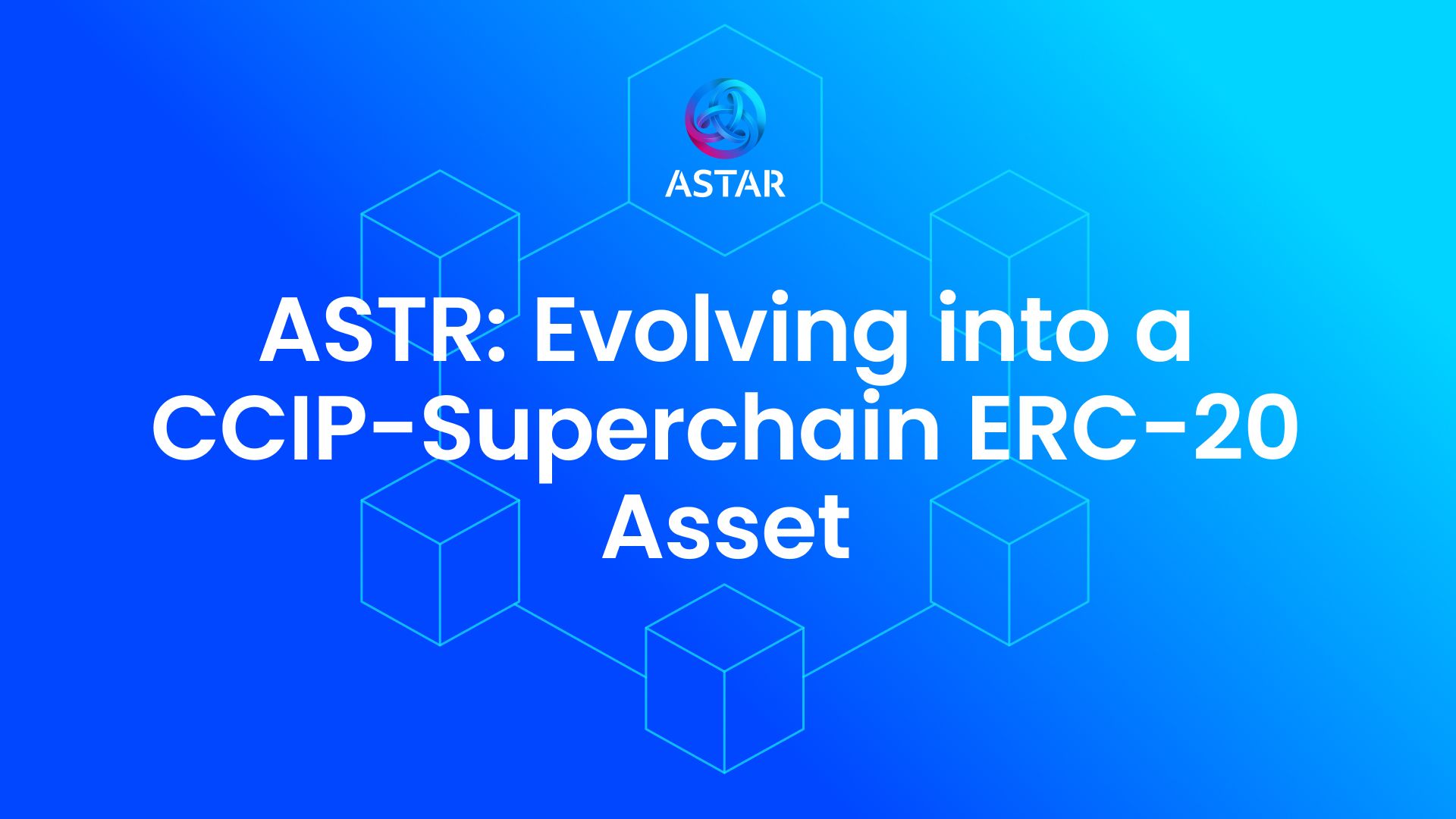Table of Contents
Astar Network is entering a new era where its native token, ASTR, can operate seamlessly across multiple blockchains.
As part of the Astar Evolution initiative, the Astar Foundation has deployed a new smart contract for ASTR that leverages Chainlink’s Cross-Chain Interoperability Protocol (CCIP) and Optimism’s SuperchainERC20 (ERC-7802) standard.
This advancement transforms ASTR from being a single network’s governance token into a cross-chain asset integral to a wider Ethereum ecosystem.
In this article, we will explore the high-level vision behind this upgrade, “Connecting Astar to Soneium and the broader Superchain, " and then dive into the technical details of how the new ASTR smart contract works. By the end, both general enthusiasts and developers will understand how ASTR’s cross-chain functionality fits Astar’s strategy and how to start building with it.
From Astar to Soneium: A new chapter in Interoperability
 Since its inception, Astar’s mission has been to connect everyone to Web3. The network is now evolving “from blockchain to collective” as part of Astar Evolution Phase 1.5. A key pillar of this evolution is interoperability. This vision became a reality with the advent of Soneium, a new Layer 2 blockchain built on Optimism’s OP Stack through a collaboration between Sony and Startale Labs.
Since its inception, Astar’s mission has been to connect everyone to Web3. The network is now evolving “from blockchain to collective” as part of Astar Evolution Phase 1.5. A key pillar of this evolution is interoperability. This vision became a reality with the advent of Soneium, a new Layer 2 blockchain built on Optimism’s OP Stack through a collaboration between Sony and Startale Labs.
To integrate ASTR into Soneium, Astar has adopted Chainlink’s CCIP to enable secure cross-chain interoperability. This allows seamless liquidity flow and unlocks cross-chain application potential between Astar and Soneium.
Why is this so significant?
In practical terms, this means that ASTR will no longer be confined to just Astar or Soneium. Instead, it can move seamlessly between them as a single unified token, fully connected via CCIP. This makes ASTR part of the most widely used interconnected ecosystem ever built in the emerging interoperable Superchain networks.
“We’re excited to see Astar adopt Chainlink CCIP to enable secure cross-chain transfers of its ASTR token. This marks a significant step in expanding Astar’s reach across the multichain ecosystem, via CCIP it’s being executed in a highly secure and reliable manner.” -Sean Chung, Blockchain Partnerships Management at Chainlink Labs
Embracing the Chainlink Standard and SuperchainERC20
 Astar’s integration of Chainlink CCIP is not just a one-off bridge, it’s part of a larger alignment with industry standards to ensure ASTR’s interoperability is future-proof. As Astar Evolution 1.5 unfolds, the plan is twofold. The process begins with rolling out a secure bridge with CCIP and upgrading the ASTR token contract to support the ERC-7802 cross-chain token standard of OP interop solutions. Once the interoperability of OP Stack is production-ready, the Astar team will upgrade the ASTR contract to allow interoperability within the broader Superchain ecosystem. In fact, ASTR is already prepared to adopt this standard to become a Superchain-adapted asset, moving seamlessly between networks like Base, OP Mainnet, and beyond.
Astar’s integration of Chainlink CCIP is not just a one-off bridge, it’s part of a larger alignment with industry standards to ensure ASTR’s interoperability is future-proof. As Astar Evolution 1.5 unfolds, the plan is twofold. The process begins with rolling out a secure bridge with CCIP and upgrading the ASTR token contract to support the ERC-7802 cross-chain token standard of OP interop solutions. Once the interoperability of OP Stack is production-ready, the Astar team will upgrade the ASTR contract to allow interoperability within the broader Superchain ecosystem. In fact, ASTR is already prepared to adopt this standard to become a Superchain-adapted asset, moving seamlessly between networks like Base, OP Mainnet, and beyond.
What exactly is ERC-7802?
In simple terms, it’s a minimal interface that token contracts can implement to allow standardized cross-chain transfers. It introduces two functions (crosschainMint and crosschainBurn), that authorized bridge contracts can call, to mint/burn tokens when they move across chains. Instead of every project inventing its bridging logic, ERC-7802 provides a common language allowing any token implementing it to be “teleported” between chains by burning on the source chain and minting on the destination chain.
The standard also defines events like CrosschainMint and CrosschainBurn, so these cross-chain movements can be transparently tracked. In essence, ERC-7802 standardizes the process, improving transparency and maintaining compatibility with existing ERC-20 functionality.
“One Superchain, One Token”
This model is exactly what Astar is adopting for ASTR. By aligning with ERC-7802, ASTR can plug into a wider interoperable network, ensuring that as the Superchain grows, ASTR grows with it as a core asset. Optimism’s Superchain initiative has embraced ERC-7802 via its SuperchainERC20 implementation with the goal that any token can operate across many OP Stack chains without fragmentation.
“The Superchain is rapidly becoming a safe, secure, and interconnected network for liquidity, applications, and users. As Superchain interop rolls out, assets like ASTR will benefit from frictionless movement between chains, with 1-block finality, zero slippage, and a unified security model. This creates an ideal foundation for DeFi growth across Ethereum and the Superchain.” - Zain Bacchus, Staff Product Manager at OP Labs
The approach avoids wrapped tokens or duplicating liquidity; instead of lock-and-mint bridges that create secondary “wrapped” tokens, the original token itself is made mintable and burnable on each chain by a canonical bridge. Tokens are typically deployed at the same address on every chain, and a unified Superchain Token Bridge is authorized to call the crosschainMint/Burn functions as needed. The benefits are significant; users can enjoy a consistent experience across chains, liquidity is not fragmented across multiple token versions, and developers have a common interface to integrate, regardless of which chain they’re on.
For Astar users and token holders, this means ASTR will truly be multi-chain. For the broader web3 industry, Astar’s adoption of CCIP and ERC-7802 demonstrates how a Polkadot-connected chain can achieve interoperability with Ethereum-based ecosystems, bridging previously siloed networks.
Inside the ASTR Smart Contract Upgrade (Tech deep dive)
 To leverage both Chainlink CCIP and the ERC-7802 standard, the Astar engineering team designed ASTR’s smart contract on Soneium with important features to achieve four core goals: enabling cross-chain minting/burning, integrating Chainlink’s infrastructure, ensuring upgradeability, and maintaining security. The result combines an upgradeable ERC-20 token contract (using OpenZeppelin’s UUPS proxy pattern) that implements the ERC-7802 interface, alongside token pool contracts integrated with Chainlink CCIP for cross-chain transfers.
To leverage both Chainlink CCIP and the ERC-7802 standard, the Astar engineering team designed ASTR’s smart contract on Soneium with important features to achieve four core goals: enabling cross-chain minting/burning, integrating Chainlink’s infrastructure, ensuring upgradeability, and maintaining security. The result combines an upgradeable ERC-20 token contract (using OpenZeppelin’s UUPS proxy pattern) that implements the ERC-7802 interface, alongside token pool contracts integrated with Chainlink CCIP for cross-chain transfers.
Let’s break down the key components:
-
ERC-7802 Interface Implementation (Cross-chain minting/burning) The ASTR token contract includes the required crosschainMint(address to, uint256 amount) and crosschainBurn(address from, uint256 amount) functions as defined by ERC-7802. These allow an authorized bridge (in this case, Chainlink’s CCIP bridge contracts) to mint new ASTR tokens on a chain when ASTR moves into that chain, or burn ASTR tokens when they move out. The contract also emits standardized events whenever cross-chain mints/burns occur, which helps with transparent tracking of funds moving between Astar, Soneium, and other networks. By adhering strictly to the ERC-7802 spec, ASTR can easily interoperate with any bridging solution or tool that recognizes the SuperchainERC20 standard.
-
Integrating Chainlink’s Infrastructure (Token Pool) Chainlink CCIP uses a concept of token pools to manage cross-chain token flows. In ASTR’s implementation, two types of pool contracts are provided: BurnMintTokenPool and LockReleaseTokenPool. The Burn/Mint approach is used for ASTR’s cross-chain teleportation model. When ASTR is sent from Astar to Soneium, the token pool on Astar locks the tokens, while the counterpart pool on Soneium mints an equivalent amount of new ASTR on Soneium. Chainlink CCIP infrastructure simplifies cross-chain validation by providing these audited token pool contracts. The ASTR contract simply grants the appropriate roles/permissions to Chainlink token pools, authorizing them to call the mint or burn functions as needed. This setup ensures that only CCIP contracts can mint/burn ASTR across chains, preventing any unauthorized entities from manipulating ASTR supply.
-
Role-Based Access Control To enforce the above, the ASTR contract employs fine-grained access control using OpenZeppelin’s AccessControl and Ownable roles. Only the designated Minter/Burner role (assigned to the CCIP token pool contract and the OP Stack’s pre-deployed Superchain Token Bridge for their Superchain Interoperability) has permission to trigger minting and burning logic. This means regular users or even regular contract calls cannot arbitrarily mint/burn tokens. All actions must follow the CCIP or Superchain interoperability flow, with granted access from the Token Owner (Astar Foundation).
-
Comprehensive Testing and Audit (Maintaining Security) Given the critical nature of a token contract, especially one handling cross-chain operations, the implementation was rigorously tested and audited. The repository includes full suites of unit tests covering standard ERC-20 behavior, cross-chain mint/burn functionality, role restrictions, and upgrade scenarios. Moreover, Astar engaged security auditors (Cyfrin) to review the codebase. The audit scrutinized the cross-chain functionality, role management, and proxy upgrade mechanisms to ensure there were no vulnerabilities. This external audit provides additional confidence to developers and users that the ASTR contract is secure against known attack vectors. (For those interested, the audit report is publicly available for review.
If you are interested in this smart contract, testing, and full deployment, you can easily check this repository here.
References: SuperchainERC20 - Optimism Docs Superchain explainer - Optimism Docs CCIP - Chainlink Docs Astar CCIP - Chainlink DevHub Soneium CCIP - Chainlink DevHub
Astar’s Cross-Chain Future and How to Get Involved
The integration of Chainlink CCIP and the ERC-7802 SuperchainERC20 standard marks a major milestone in Astar’s evolution. What started as a standalone blockchain is now transforming into a collective, interconnected ecosystem. By making ASTR a cross-chain token, Astar is expanding its reach into new networks, starting with Soneium and in the future expanding to Base and OP Mainnet. Moreover, aligning with the broader trend of the Superchain, ASTR is effectively positioned to be a bridge across many worlds in web3. For developers and ecosystem partners, now is the perfect time to join this cross-chain journey. If you’re building on another network within the Superchain, ASTR can become an interoperable asset in your application as well, thanks to its ERC-7802 compliance. We encourage developers to explore the open-source code on Github, review the technical documentation, and experiment with CCIP in a test environment.
Users can seamlessly bridge ASTR from the Astar Network to Soneium in a single transaction since Chainlink CCIP is integrated into the Astar Portal. As Superchain interoperability matures, transferring ASTR across any Superchain network will become just as effortless, enabling users to move assets throughout the entire ecosystem with only two clicks.
--Written by Taegeon Alan Go, Fullstack Engineer at Startale

